Top>Education>Volunteer activities for student growth
 Index
Index
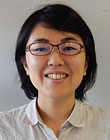
Mariko Matsumoto
[profile]
Volunteer activities for student growth
Mariko Matsumoto
Coordinator, Chuo University Volunteer Center
Establishment of the Volunteer Center
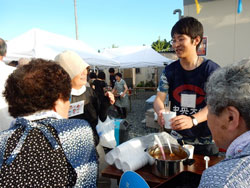
In April 2013, the Volunteer Station (renamed the Volunteer Center the following year), was established in the Tama Campus Student Affairs Section. The center is staffed with two full-time coordinators who provide information and consultations for students wishing to take part in volunteer activities, and liaise with regions where student volunteers are necessary. The main aim of the center is to encourage student growth through volunteer activities. Going to the actual areas facing various issues, mobilizing knowledge acquired at university, and contributing to society with knowledge and tools brought by the volunteer members lead to the university’s founding spirit of “fostering the ability to apply knowledge to practice.”
Student action
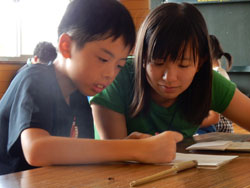
The Great East Japan Earthquake provided the opportunity to establish the Volunteer Center. Many students and staff put their hands up to be volunteers in the disaster-struck region. Five years after the disaster, there is still a mountain of problems facing the area, and starting with the 4 groups making up the Disaster Region Student Support Group![]() , which belongs to the center, the center continues to send students for disaster area support activities. This summer 75 students visited the region. Students visiting the disaster area for the first time were surprised to see so much had yet to be restored. The experience gave them a glimpse of reality outside of the university. The communities that received the students were filled with anticipation as elderly residents and children wanting to play with university students turned up at the temporary assembly halls. A Kesennuma elementary school teacher mentioned, “teachers and students here are grateful to have Chuo students coming to stay with us during their long vacation,” implying that by continuing to visit the region, Chuo students have almost become indispensable to them. Also, through these connections, there have also been students who entered the university after finding out about Chuo and our activities in the disaster region. University students are a rare sight in the lightly-populated coastal area, and the influence exerted by the students’ activities in the area is not small.
, which belongs to the center, the center continues to send students for disaster area support activities. This summer 75 students visited the region. Students visiting the disaster area for the first time were surprised to see so much had yet to be restored. The experience gave them a glimpse of reality outside of the university. The communities that received the students were filled with anticipation as elderly residents and children wanting to play with university students turned up at the temporary assembly halls. A Kesennuma elementary school teacher mentioned, “teachers and students here are grateful to have Chuo students coming to stay with us during their long vacation,” implying that by continuing to visit the region, Chuo students have almost become indispensable to them. Also, through these connections, there have also been students who entered the university after finding out about Chuo and our activities in the disaster region. University students are a rare sight in the lightly-populated coastal area, and the influence exerted by the students’ activities in the area is not small.
Using the five senses
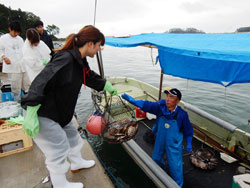
Activities in the disaster region do not involve physical labor such as debris removal, but are based on interaction with the people. The community overflows with the smiles of students, local elderly residents and children. The disaster region student support group “Hamarainya”, under the slogan “giving strength to live today,” holds activities including tea parties in the assembly halls of temporary housing communities. Through these activities, and exchange with the residents, students are attentive to the sorrows behind the smiles of the residents who are facing intense difficulties and anxieties, and work to provide a shoulder for them to lean on. The tone of voice, talking slowly, and being sincere, are the key factors students work to create an atmosphere so residents can feel comfortable opening up to them. Students are expected to use their five senses so they can catch even the slightest changes of the residents. Chuo students spent time with children also. When the student group Omose Study Support first started to play and help with the children’s studies in 2012, the children plead for piggy-backs and hugs, played pranks to gain attention, ran around and laughed in loud voices, and were full of energy. The children were going through a lot of stress and anxiety brought about by the great change to their family who were struggling from the disaster and had not been able to act like children since the day, according to the community. In order to notice their latent needs, students need skills to make a calm observation while playing with them. These skills cannot be obtained just by reading literature and learning in the classroom. By going to the volunteer sites your mind and body is repeatedly stimulated.
Pre-activity goal-setting and post-activity reflection
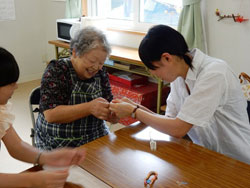
Volunteer activities also involve pre-activity goal-setting and post-activity reflection for development as the important process. Students are able to build their independence by defining a clear sense of purpose of their activities before departure. The word “volunteer” is often attached to an idea of “service” or “self-sacrifice”, but the most important aspect of volunteer work is “independence and self-motivation.” (Reference: Volunteer Center HP “Philosphy and History![]() ”)
”)
In the process of defining a clear sense of purpose, students investigate the situation of the community, hold discussions between each other, and invite professionals to give intensive courses and psychological support workshops. Gathering information and visualizing before departing, then developing the skills to perceive the difference between reality and that image will help expand the student’s knowledge and adaptability to the community.
Reflection takes place post-activity, basically during the term of the volunteer activities, leading to an improvement in the following activities. This is called turning the so-called “PDCA cycle.” Student performance abilities improve in the cycle of setting goals and a plan, putting it to practice, repeating the action and linking it to the next course of action. Also, after the long summer vacation, the Volunteer Center hosts a Reflection Workshop by getting together students who took part in volunteer activities. Rather than reflecting on failures, the point of focus is placed on taking an overhead view of the activities. Volunteer activities consist of the relationship between the NPOs and citizen groups accepting the student volunteers, regions and communities in addition to the relationship between oneself and the other person (supporter). By thinking of what influence (benefit) your activities will have on the various groups involved, and what social issues to link the issues at hand to, your own position in society can be defined. Students also think about how they can utilize their skills in society, and what kind of society they desire as a member of that society. This would ideally be made clear during their time at university and before heading out into society. The coordinators plan these programs and give support to the students while ascertaining their situations.
What we have gained
The series of volunteer activities brings about various positive influences. One feedback from a student mentioned that they were able to digest lectures differently. By coming in contact with people from the communities, their appetite for growth has increased, and they become able to proactively select courses and seminars with an awareness of the issues. They are also contributing to community development in the Tama area. By realizing the necessity of disaster prevention and community building in the disaster region, the students have started putting that to practice in the neighborhood. In 2014 in the Hirayama area of Hino City, a student-initiated “Disaster Reduction Walk Rally” was held, with a total of 180 students and members of the community participating. The activities also have an influence on employment. Chuo graduates who conducted volunteer activities in the disaster region took on their job-hunting activities with a sense of purpose and received job offers in the government, newspaper companies and major airlines. It is clear that these graduates were able to foster strong communication skills, comprehension skills, and skills to see the big picture that also contributed to their job-hunting activities.
Clear effectiveness and collaboration
I have explained how volunteer activities promote student growth, but in doing so there are several issues. A major issue is human cost. In order to extend skills by bringing out student autonomy and coordinate the needs of the region, continuous involvement is required by adults to deal with individual matters, when in reality there are only two coordinators in the Center. In order to expand the scope of activities, it is clear that the involvement of a diverse range of people including faculty, staff and members of the community, is indispensable. However in order to do so, we must create a system of visualizing student development that can be shared among the members. We are currently preparing a visualization of results, which we will present on December 5 at C-Square on Tama Campus. We will also give a summary of Volunteer Center activities and student growth. If you are interested, please join us.
Conclusion
Roughly 10 students visit the center every day. While there are students with clear ambitions, there are also students who come searching for a place in their university lives and something worthwhile to do, wanting to challenge something, building confidence, participating in a club, or even wanting to have a dream. The Volunteer Center not only supports students to become future leaders in society, but also aims to provide a place that supports the developmental steps of each and every student.
-
Mariko Matsumoto
Coordinator, Chuo University Volunteer Center - Mariko Matsumoto was born in Chiba in 1981. She graduated from Meiji University School of Political Science and Economics in 2004. She was involved in the startup of a career education NPO group while at university. After working on the Funabashi Board of Education, as a community newspaper journalist and event organizer of local production for local consumption, she became public relations and regional coordinator for “Onagawa Kougakukan Collaborative School” (Administrator: Authorized NPO Katariba), an after school program for children in Onagawa Town, Miyagi Prefecture, from September 2011. She assumed the current position in April 2013.
- Research Activities as a Member of Research Fellowship for Young Scientists (DC1), Japan Society for the Promotion of Science (JSPS) Shuma Tsurumi
- Important Factors for Innovation in Payment Services Nobuhiko Sugiura
- Beyond the Concepts of Fellow Citizens and Foreigners— To Achieve SDGs Goal 10 “Reduce Inequality Within and Among Countries” Rika Lee
- Diary of Struggles in Cambodia Fumie Fukuoka
- How Can We Measure Learning Ability?
—Analysis of a Competency Self-Assessment Questionnaire— Yu Saito / Yoko Neha - The Making of the Movie Kirakira Megane








